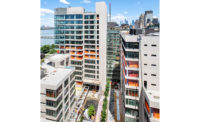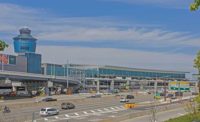The $5.1-billion Terminal B redevelopment at LaGuardia Airport in New York City—the largest U.S. aviation project in a public-private partnership—has earned the first Envision Platinum rating under a revamped and broadened version of the seven-year-old program that has pioneered sustainability measures for civil infrastructure projects.
The new Envision Version 3 framework (V3), released in 2018 by the Washington, D.C.-based Institute for Sustainable Infrastructure, has expanded the criteria projects must meet—adding detail in areas such as resilience, economic impact, social justice and construction practices, says Anthony Kane, ISI president and CEO.
“Project teams have been doing well on Version 2, and we saw the industry was ready to push it to the next level,” he says. The LaGuardia upgrade is also the first infrastructure project to complete the rating process with the added V3 criteria.
ISI launched the Envision certification program in 2012, the creation of three industry engineering associations and Harvard University.
The Terminal B rating reflects efforts at LaGuardia by the Skanska-Walsh construction joint venture and design partners HOK and WSP USA, as well as the Port Authority of New York & New Jersey and LaGuardia Gateway Partners, the P3 joint venture.
The project, which includes a 35-gate terminal, central hall, parking garage, roadways and infrastructure, began in 2016 and wraps up in 2022
The new standards have “more holistic indicators of social and economic sustainability,” says the project’s design-build team.
'Above and Beyond'
To earn Platinum, the project “went above and beyond conventional practice” in taking steps to deliver environmental, economic and community benefits during the project and over its longer life cycle, Kane says.
V3 now has 64 sustainability criteria across five categories, up from 60. A project also now can seek outside verification of Envision criteria at or after 95% design completion, or at or after 95% construction completion. If done at the design stage, a post-construction follow-up review is now required to maintain the rating.
Under the new version, construction-focused credits can be gained in categories that include improved construction safety, minimized construction impacts, and reductions in construction waste, construction energy use and water consumption.
The project has reduced need for lighting, saving 19% in net energy costs, and added features to cut water use by 40%.
One key effort is reuse or recycling of materials from extensive demolition of existing structures.
The team recycled nearly 100% of the debris from the original terminal’s parking garage, amounting to 21,604 tons of concrete, with 2,475 tons reused on site. Other key elements include reusing groundwater pumped from excavation to make concrete and minimized noise, vibration and other impacts on the community.
In response to a late August New York Times report on construction impacts adding to recent traffic gridlock and major passenger transportation difficulties at the airport, Port Authority officials say that La Guardia has experienced 8 of the 12 highest volume days in its history in summer 2019, with police presence boosted by 50% to manage traffic in addition to a round-the-clock traffic operations center that seeks to resolve issues in real time
“More than 90% of the time, the airport has handled these record numbers of passengers reasonably well," says a Port Authority spokesperson.
"But during some hours on some of these peak summer days, the temporary construction network has struggled, and created profound frustration and inconvenience despite extensive around-the-clock efforts by the airport to manage the traffic. We apologize for that inconvenience and ask the public for their patience during the construction period."
Building in Resilience
The team's design that accommodates a possible AirTrain light rail connection at Terminal B is aimed at resolving the airport's long-standing road-only access challenges—if permits and financing become reality for what is estimated as a $2 billion project.
The project team also has reached out to the community on efforts such as a $1.8-million local ball field reconstruction and launch of an eight-week academic program to teach younger students the fundamentals of 3D virtual design.
The rating also recognized design plans to enable the terminal to avoid damage not only from current floods but also from those in the future based on projections of rising sea levels—meeting new Envision climate and resilience requirements that reflect lessons learned from Superstorm Sandy.
“After Sandy, we saw the need for a renewed focus on resilience, and in that time, we learned a lot about it,” Kane says. “We knew we had to improve that.”
Skanska previously delivered the first Envision-verified wastewater treatment plant and rail transit project in the U.S., both under Version 2, and is among industry firms that participated to develop the V3 program.
Another 14 projects now are in process to gain a V3 rating, says Melissa Peneycad, ISI managing director for sustainable projects.
“LaGuardia was the first—they knew they wanted to move on it,” she says.






